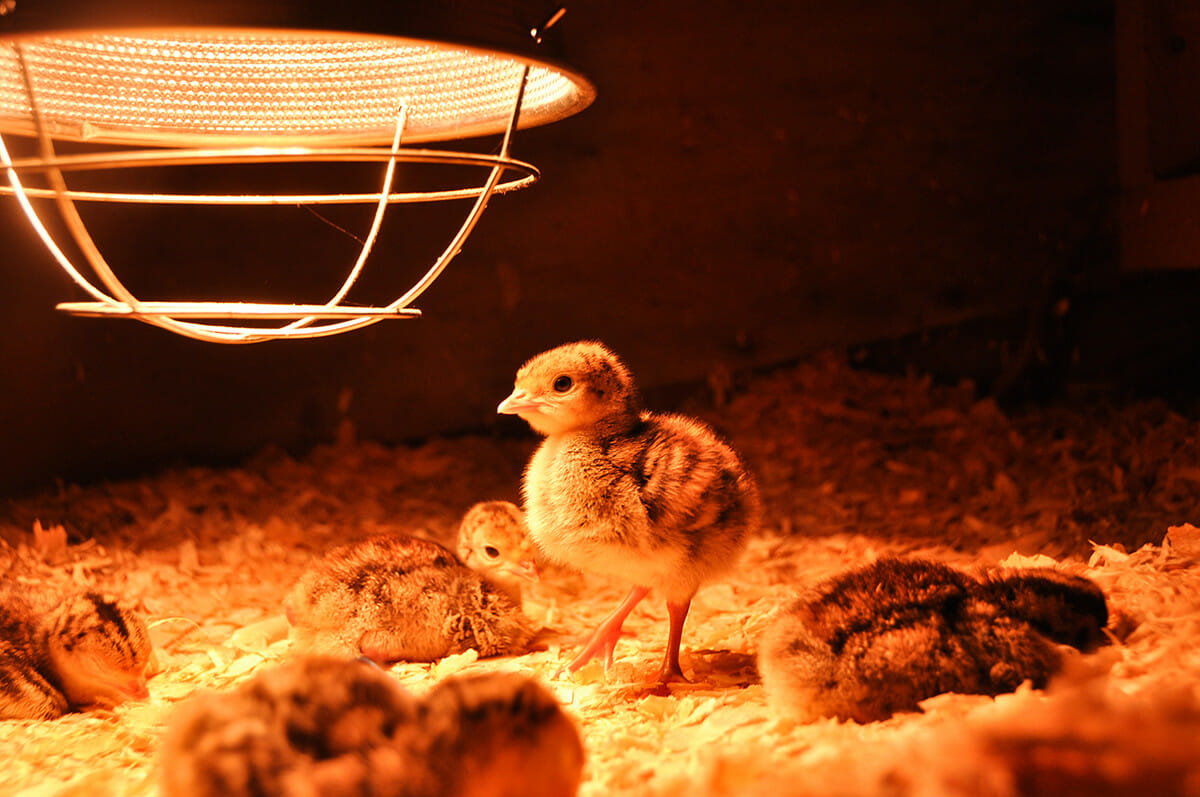By Brian Barth on April 15, 2015

Shutterstock Photography
Step 1 – Build a Container
Build is a relative term here. Many people raise chicks in a cardboard box. Play pens, kiddie pools, rabbit hutches, aquariums, plastic totes and other items likely to be found in a garage, barn or basement will suffice. You can build a custom chick mansion with private bedrooms for each one if you want, but the general rule of thumb is to provide at least one square foot of space per chick. For the first few weeks a small fraction of that space is fine, so one option is to start small and add on later.The container needs to be at least 12 inches tall for chicks in weeks one to three, but by the time they are six weeks old the walls should be 24 inches high to keep them from hopping out. Or, you can add a lid. A lid is a necessity if there are pets or other creatures that may pose a threat to your baby chicks. Chicks need fresh air, however, so the lid needs to be completely breathable – hardware cloth or window screen stapled to a wooden frame is an easy way to go.
The brooder needs to be out of the elements so the chicks are warm, dry and safe from nighttime predators. A barn, garage or your living room are all fine options. You can also place the brooder inside the chicks’ future home – the coop.
Step 2 – Outfit the Brooder
Pine shavings are the bedding of choice for baby chicks. The essential oils in cedar shavings can cause respiratory distress and newspaper is hard for them to walk on when they’re little.Spread an inch or two of shavings on the floor of the brooder and set up a watering and feeding station at one end. There are various DIY options for chick waterers and feeders, but the basic models only cost a few bucks at the feed store. Nipple-style waterers are highly recommended because the chicks can’t foul them with feces – good hygiene is critical to keeping chicks healthy.
On the other end of the brooder, set up a heat lamp. If you have your chicks in the living room where it’s 65 degrees at night, a 100-watt incandescent bulb in a clamp-on utility light (the kind with a metal reflector) will provide enough warmth. If they’re in a barn, garage or another location that gets chilly, a heat lamp is in order. These special bulbs can be found at feed stores or ordered online.
The height of the bulb may need to be adjusted anywhere from 12 to 36 inches above the bottom of the brooder to maintain the optimal temperature for the chicks. One easy way to accomplish this is to hang the light fixture by a chain attached to a hook above the brooder.
If hot bulbs in close proximity to a cardboard box filled with wood shavings and baby chicks makes you nervous (it definitely qualifies as a fire hazard), consider an EcoGlow brooder heater, which are also designed to save energy.
Step 3 – Care for Your Chicks
Chicks need to be at a constant temperature of around 95 degrees for the first week of their life. Mail-order chicks are almost always less than 48 hours old; if you get your chicks at a feed store, ask how old they are before bringing them home. Adjust the height of the bulb and use a thermometer to measure the temperature at the bottom of the brooder to get it into the proper range before the chicks arrive.Dip the beak of each chick into the water source as you put it in the brooder so it knows where to go when it’s thirsty.
The chicks will tell you if they are too hot or too cold: if they are huddled on top of each other directly under the bulb, move the bulb closer to warm them up; if they are pushing against the opposite wall of the brooder away from the bulb, it’s way too hot. Chicks milling about throughout the brooder is a good sign that the temperature is just right.
Lower the temperature of the brooder by about 5 degrees each week. As the chicks’ feathers fill in, they are more tolerant of cold, but they are also prone to overheating, so it’s important to keep the temperature just right.
Food and water should be available at all times. Chicks need a special ‘starter feed‘ during their time in the brooder. Starter feed has a crumbly texture, but gets clumpy when moist. If this occurs, clean out the feed tray and add fresh food to avoid mold developing.
It’s a good idea to clean out the food tray every few days anyway because the chicks can’t reach every bit and it will start to get stale. Waterers should be cleaned out daily (unless you’re using nipple waterers, which don’t require cleaning), and the bedding should be refreshed every other day by scooping out the top layer and adding shavings.
Once the chicks are six weeks old, their feathers should be filled out and they are capable of tolerating cool nighttime temperatures – so it’s time to transfer them to the coop. To smooth the transition, move the heat source, feeder and waterer into the coop for the first few days, and set up an adult-size feeder and waterer.